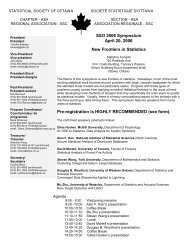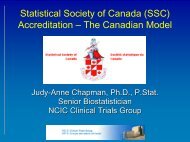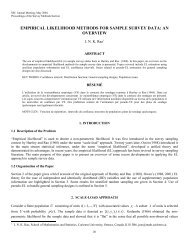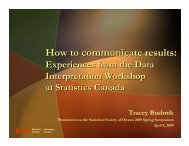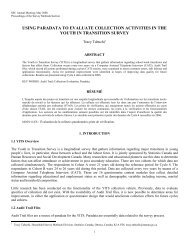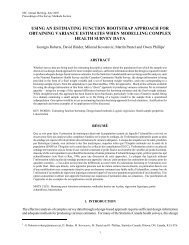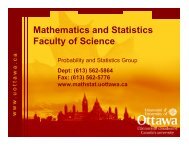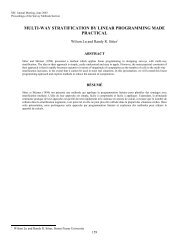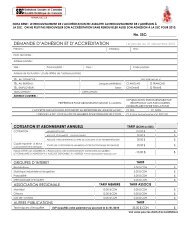Programme et résumés (pdf) - Société statistique du Canada
Programme et résumés (pdf) - Société statistique du Canada
Programme et résumés (pdf) - Société statistique du Canada
Create successful ePaper yourself
Turn your PDF publications into a flip-book with our unique Google optimized e-Paper software.
82 Lundi 29 mai • Monday, May 29, 10:30–12:00patients. Incorrect trial decisions are even more tique. De mauvaises conclusions suite à ces essais sont parcostlyin terms of future patients and finances. A ticulièrement coûteuses, tant financièrement qu’en terme deMarkov chain transition rate model utilising con- futurs patients. Un modèle basé sur la construction d’uneditional power m<strong>et</strong>hods is proposed to increase the chaîne de Markov <strong>et</strong> utilisant des méthodes de puissanceinformation available and improve decision mak- conditionnelle est ici proposé afin d’augmenter la quantitéing. Repeated measurements on a single patient are d’information disponible <strong>et</strong> d’améliorer la prise de décision.incorporated through the Markov chain, and condi- La chaîne de Markov perm<strong>et</strong> d’incorporer des mesures répétionalpower allows for a group-sequential design, tées provenant d’un même patient. Les méthodes de puisthus,early termination of trials with futile treat- sance conditionnelle perm<strong>et</strong>tent l’utilisation d’un plan séments.Illustrative examples will be presented of quentiel par groupes <strong>et</strong> donc, l’interruption rapide des essaistrials performed at Princess Margar<strong>et</strong> Hospital. liés à des traitements inutiles. Des exemples issus d’essaiscliniques effectués à l’hôpital Princess Margar<strong>et</strong> seront présentésà titre illustratif.[MS-44]A Robust Two-Group Step-Down Test for Multiple OutcomesUn test descendant robuste à deux groupes pour des résultats multiplesLisa LIX & Kathleen DEERING, University of ManitobaDans les essais cliniques, il est souvent d’intérêt d’examinerla différence entre le groupe de traitement <strong>et</strong> le groupe decontrôle sur des résultats multiples quand on s’attend à ceque le traitement ait un eff<strong>et</strong> positif sur tous les résultats.Peu de tests d’hypothèses alternatives multivariées direc-tionnelles ont été proposés pour le cas où les covariancessont hétérogènes <strong>et</strong> la distribution a une queue lourde. Nousproposons un test composé de degrés de liberté approxima-tifs avec les estimateurs tronqués basés sur les analyses deméthodes « descendante » de Roy (1954). L’exactitude del’approximation est vérifiée par des simulations, <strong>et</strong> les com-paraisons sont faites avec un test de ratio de vraisemblanceapproximative <strong>et</strong> un test non paramétrique pour le problèmede Behrens-Fisher.In clinical trials, it is often of interest to test thedifference b<strong>et</strong>ween treatment and control groupson multiple outcomes when the treatment is expectedto have a positive effect on all outcomes.Few tests of directional multivariate alternative hypotheseshave been proposed for the case when covariancesare h<strong>et</strong>erogeneous and the distribution isheavy-tailed. We propose a composite approximatedegrees of freedom test with trimmed estimatorsbased on Roy’s (1954) step-down analysis. The accuracyof the approximation is verified by simulations,and comparisons are made with an approximatelikelihood ratio test and a non-param<strong>et</strong>ric testfor the Behrens-Fisher problem.[MS-45]A Maximum Likelihood Estimator for the Analysis of Randomized Trials with Treatment Noncomplianceand Subsequent NonresponseUn estimateur <strong>du</strong> maximum de vraisemblance pour l’analyse d’essais cliniques aléatoires en présence denon-observance <strong>et</strong> de non-réponseYang ZHAO, University of ReginaLa non-observance de traitement <strong>et</strong> la non-réponse subséquentesont des problèmes courants dans l’analyse d’essaisrandomisés. Dans c<strong>et</strong>te recherche, je considère des méthodesd’estimation de l’eff<strong>et</strong> causal de l’assignation de traitementpour un essai clinique randomisé à deux groupes basées surle maximum de vraisemblance. Je décris un algorithme ité-ratif re-pondéré pour obtenir un estimateur de l’eff<strong>et</strong> causal.Des expressions analytiques perm<strong>et</strong>tant de m<strong>et</strong>tre à jour lesTreatment non-compliance and subsequent nonresponseare common problems in the analysis ofrandomized trials. In this research I consider maximumlikelihood m<strong>et</strong>hods for the estimation of thecausal effect of treatment assignment for a twoarmedrandomized trial. I will describe an iterativere-weighted algorithm to obtain a maximum likelihoodestimator of the causal effect. Closed formSH = Somerville House SSC = Social Science Centre UC = University College



